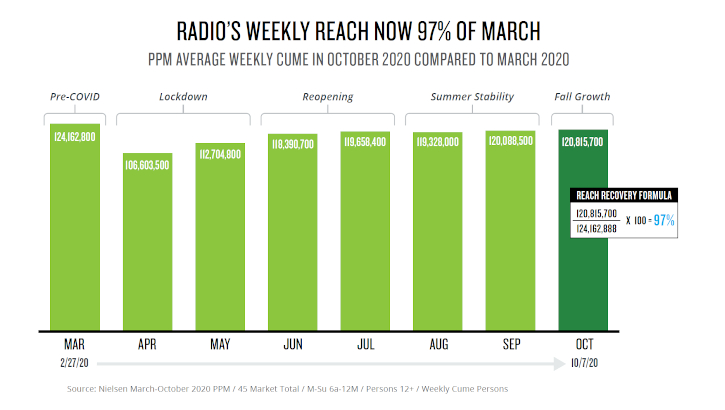As the nation recovers, so do radio listening levels in many markets around the country. That’s the consensus of a new research report from Nielsen titled “Audio Today: On the Road to Recovery With AM/FM Radio.”
Audio usage in 2020 has certainly been interesting, said Brad Kelly, managing director of Nielsen Audio. Despite conventional wisdom, radio listening did not dissolve when commuting patterns changed. Instead, some of that drive-time listening migrated into home listening via to digital assistants like Alexa and Google Dot. “Audio usage continues to evolve and morph in new ways,” Kelly said in the report. “COVID-19 didn’t change that — it just accelerated it.”
[Read: Bouvard: More People Are “Ready to Go”]
The data is also telling another story about a group of American consumers who have remained mobile through the pandemic, a group Nielsen dubbed the Ready to Go consumer group. “For these people, radio is more than a distraction, it’s a lifeline,” Kelly said. Nielsen found that this group is more ready to engage, eager to make major purchases sooner and typically has a more optimistic view on the future.
More often than not these highly mobile people are essential workers who are have consistently tuned into radio throughout the pandemic, the report found. “[T]he people we now rely on most, they rely on radio,” he said.

“As you look at trendlines in the first few graphs and your eye naturally gravitates to the ‘lockdown’ low spot, be sure to keep in mind the foundational underpinning of these audience numbers and who was doing the heavy lifting,” Kelly said, referring to the essential workers who were on the job throughout the pandemic and continued to consume radio. “And remember to thank one of those folks the next time you see them.”
The report breaks down radio listening into specific subcategories: pre-COVID, lockdown, reopening, summer stability and fall growth. Nielsen said that with the onset of fall, changes in working and commuting patterns — along with a return to school in some areas — are sparking growth in radio listening.
Nielsen tracked the past eight months of data in the top 50 radio markets as measured by Nielsen’s Portable People Meter and found that radio’s weekly reach through early October recovered to within three points of March levels. This continues an upward trend that began during the reopening period in June and July.
The report does not address, however, what the impact the rising number of coronavirus cases in late October and November will have after a term of summertime stability.
Through early October, Nielsen found that radio’s weekly reach was 97% of March levels. Along those same lines, the report found that radio’s AQH in October 2020 is now 95% of March levels.
The report also revealed that drive time recovery continues as commuting increases. “At the beginning of the pandemic, radio use during traditional commute times initially declined, but it has grown each month since then, with significant recovery in October,” the report revealed. “Morning drive in particular increased by 11% from September to October, while weekends have now moved ahead of March levels.”
The report also found that nearly 70% of AQH (average quarter hour) listening is at out-of-home locations. In April, those figures dropped to 58% from a pre-COVID high of 71%. As of October, those figures were back up to 69%. That may be attributable to the fact that radio is on as parents commute their children to school. The report found that 62% of those who drive their children to class have their radio always on, followed by 35% who say that the radio is sometimes on. Those figures far outweigh those drivers who say their radio is rarely on (3%) or never on (1%).
“[This report tells] a story of how radio usage has changed during the course of the 2020 rollercoaster ride and how it’s tracking in-sync with the recovery,” Kelly said.










